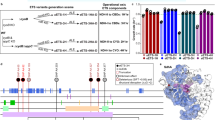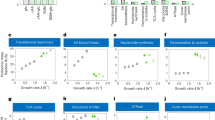Abstract
Rational design of novel as well as improved cellular biocatalysts by genetic manipulation of cellular metabolism has recently attracted considerable interest. A wide range of bacteria have been genetically modified by integrating new enzymatic functions into their metabolic network1–7. A central problem in the aerobic growth of any cell culture is the maintenance of dissolved oxygen (DO) concentrations above growth-limiting levels especially in high cell-density fermentations which are usually of a fed-batch type. The optimal rate of nutrient addition (and consequently the productivity) is ultimately limited by the rate at which cells can aerobically catabolize the carbon source without generating growth-inhibitory metabolites such as lactate and acetate8,9. All approaches thus far have concentrated on improving the oxygen mass transfer rates by manipulating various environmental parameters. We10 have isolated the gene for a haemoglobin-like molecule, expressed by the aerobic bacterium Vitreoscilla in poorly-oxygenated environments11,12, and expressed it in Escherichia coli. The recombinant cells contain enhanced haem as well as active haemoglobin, and they grow faster and to considerably greater cell densities than comparable plasmid-containing cells which do not express haemoglobin. This haemoglobin increases the rate of oxygen use, especially when dissolved oxygen is less than 5% of air saturation.
This is a preview of subscription content, access via your institution
Access options
Subscribe to this journal
Receive 51 print issues and online access
$199.00 per year
only $3.90 per issue
Buy this article
- Purchase on Springer Link
- Instant access to full article PDF
Prices may be subject to local taxes which are calculated during checkout
Similar content being viewed by others
References
Reineke, W. & Knackmuss, H. J. Nature 277, 385–386 (1979).
Ensley, B. D. et al. Science 222, 167–169 (1983).
Anderson, S. et al. Science 230, 144–149 (1985).
Hopwood, D. A. et al. Nature 314, 642–644 (1985).
Mermod, N., Harayama, S. & Timmis, K. N. Biotechnology 4, 321–324 (1986).
Stanzak, R., Matsushima, P., Baltz, R. H. & Rao, R. N. Biotechnology 4, 229–232 (1986).
Windass, J. D. et al. Nature 287, 396–401 (1980).
Zabriskie, D. W. & Arcuri, E.J. Enzym. microb. Technol. 8, 706–717 (1986).
Tsai, L. B. et al. J. ind. Microbiol. 2, 181–187 (1987).
Khosla, C. S. & Bailey, J. E. Molec. gen. Genet. (submitted).
Wakabayashi, S., Matsubara, H. & Webster, D. A. Nature 322, 481–483 (1986).
Boerman, S. J. & Webster, D. A. J. gen. appl. Microbiol. 28, 35–43 (1982).
Anraku, Y. & Gennis, R. B. Trends biochem. Sci. 12, 262–266 (1987).
Cox, R. & Charles, H. P. J. Bact. 113, 122–132 (1973).
Webster, D. A. & Liu, C. Y. J. biol. Chem. 249, 4257–4260 (1974).
Oosterhuis, N. M. G. & Kosen, N. W. F. Biotechnol. Bioengng. 26, 546–550 (1984).
Vardar, F. Process Biochem. 18, 21–23 (1983).
Wittrup, K. D., Mann, M., Fenton, D., Tsai, L. & Bailey, J. E. Biotechnology (submitted).
Author information
Authors and Affiliations
Rights and permissions
About this article
Cite this article
Khosla, C., Bailey, J. Heterologous expression of a bacterial haemoglobin improves the growth properties of recombinant Escherichia coli. Nature 331, 633–635 (1988). https://doi.org/10.1038/331633a0
Received:
Accepted:
Issue Date:
DOI: https://doi.org/10.1038/331633a0
This article is cited by
-
Optimization of trans-4-hydroxyproline synthesis pathway by rearrangement center carbon metabolism in Escherichia coli
Microbial Cell Factories (2023)
-
Metabolic engineering strategy for synthetizing trans-4-hydroxy-l-proline in microorganisms
Microbial Cell Factories (2021)
-
Myxococcus xanthus truncated globin HbO: in silico analysis and functional characterization
Molecular Biology Reports (2019)
-
Rhizobium etli bacteroids engineered for Vitreoscilla hemoglobin expression alleviate oxidative stress in common bean nodules that reprogramme global gene expression
Plant Biotechnology Reports (2016)
-
A novel biocatalyst for efficient production of 2-oxo-carboxylates using glycerol as the cost-effective carbon source
Biotechnology for Biofuels (2015)
Comments
By submitting a comment you agree to abide by our Terms and Community Guidelines. If you find something abusive or that does not comply with our terms or guidelines please flag it as inappropriate.



